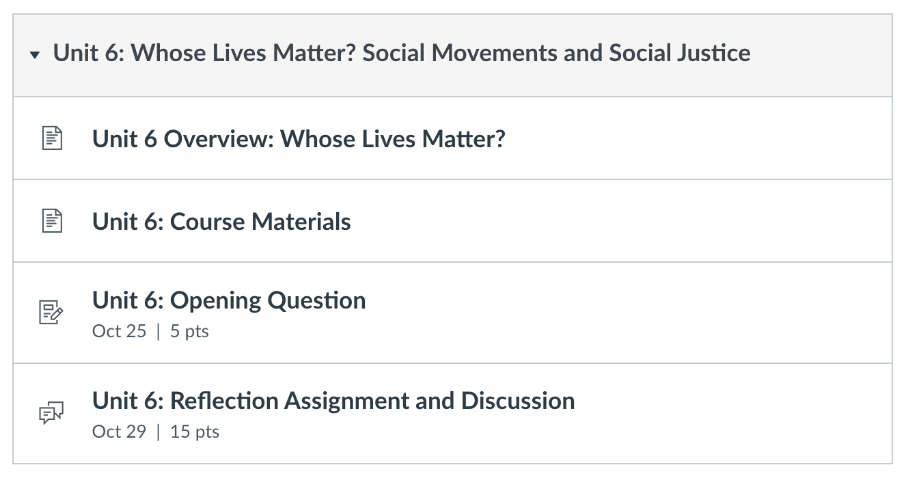3.1 What’s a module template?
A module template lays out the desired sequence of content and assignments for the term. Consistency in course site design is important so that students can predictably locate content and so that the student workload each week is clear. Dividing your course into units or modules creates a coherent and user-friendly pathway.
Instructors often use pages to group collected content so that the module-level view isn’t too crowded or busy. Pages are great because they allow instructors to frame and link to content so that students have a stronger sense of direction and engagement.
Once you have a module template, you can copy it so that each week or unit follows the same structure.
Suggested Module Template
- Week Two [Content Theme]
- [Page] Week 2 Overview
- On this page, instructors can provide a short text introduction to the themes or concepts of the week. They can introduce an introductory question or image, or provide more context for the week’s goals.
- Instructors can also share learning objectives for this week or unit: What will students be able to do or to know after they complete the module?
- Ideally the Overview Page will also provide reminders of the weekly work and links to the following sections of the module.
- [Page] Week 2 Course Materials
- Typically each module or unit will include required reading and required media to watch or listen to. It is very helpful to use the page structure to divide readings from media so that students can budget their time accordingly. It is also important to use the bulleted or numbered list feature so that students using screen reader software can easily track all completed content.
- It is super helpful to annotate readings and media elements. What do you want students to think about as they engage? Are there key words you want them to pay attention to?
- For any media you want students to view or listen to, please include the viewing time (Viewing time: 4 minutes 30 seconds). This helps students manage their available study time effectively.
- It’s a great idea to separate what is required from what is optional or intended for further study if students have time. Including a section
- [Page] Week 3 Discussion/Assignment
- After the Week 2 Overview and Week 2 Course Content pages, it’s a great idea to add any assignments or discussions required for the week.
- By adding assignments or discussions at the end of the module, they stand out as required tasks.
- If an assignment is due in a few weeks, it’s a great idea to add it early so that students can review the purpose, tasks, and criteria for success before the assignment is due.
- [Page] Week 3 Wrap Up
- A wrap up page is an important tool for helping students bridge or transition between weeks or units. In this space, you help students prepare for the week ahead by summarizing what this week covered, offering a final reflection question, or synthesizing key points you don’t want them to miss.
- Usually this page is pretty short and offers a statement of encouragement and support as students move on to the next module or unit.
- [Page] Week 2 Overview
Screenshot of a Sample Module Template

Licenses and Attributions
“Screenshot of a Sample Module Template” by Kim Puttman and Veronica Vold for Open Oregon Educational Resources is licensed under CC BY 4.0.
All other content on this page is by Veronica Vold for Open Oregon Educational Resources and is licensed under CC BY 4.0.

